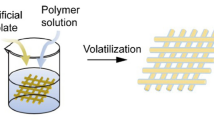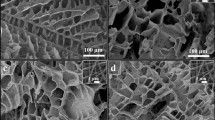Abstract
Tissue engineering presents an alternative approach to the repair of a damaged tissue by avoiding the need for a permanent implant made of an engineered artificial material. A suitable temporary scaffold material that exhibits adequate mechanical and biological properties is required to enable tissue regeneration by exploiting the body’s inherent repair mechanism, i.e. a regenerative allograft. Synthetic bioresorbable polymers have been attracting attention as tissue engineering scaffolds. However, a number of problems have been encountered such as inflammatory responses and lack of bioactivity. Another good candidate for a tissue engineering scaffold is the calcium phosphates because of their good biocompatibility and osteointegrative properties. Their slow biodegradation is still remains problem, especially for the filling of large bony defects. In this study, we investigated the fabrication method of a three-dimensional reticulated scaffold with interconnected pores of several hundred micrometers using calcium phosphate glass in the system of CaO-CaF2-P2O5-MgO-ZnO and a polyurethane sponge as a template. Calcium phosphate glass slurry was homogenously thick coated when the weight percentage of the calcium phosphate glass powder was 40% with 8 wt% of polyvinyl alcohol as a binder. Addition of 10 wt% dimethyl formamide as a drying control chemical additive into a slurry almost prevented the crack formation during drying. Sintering of the dried porous block at 850°C exhibited the densest microstructure as well as the entire elimination of the organic additives. Repeating the process significantly increased compressive strength of sintered porous body due to the thickening of the struts. To summarize, macroporous calcium phosphate glass can be fabricated with 500∼800 μm of pore size and a three-dimensionally interconnected open pore system. It is thought that this kind of biodegradable glass scaffold combined with osteogenic cells has potential to be studied further as a tissue-engineered bone substitute.
Similar content being viewed by others
References
G. J. NAUGHTON, W. R. TOLBERT and T. M. GRILLOT, Tissue Eng. 1 (1995) 211.
N. F. BISSADA and U. HANGORSKY, Dent Clin North Am. 24 (1980) 739.
A. MIZUTANI, T. FUJITA, S. WATANABE, K. SAK- AKIDA and Y. OKADA, Int Orthop. 14 (1990) 243.
J. R. MOORE, T. W. PHILLIPS, A. J. WEILAND and M. A. RANDOLPH, J. Orthop. Res. 1 (1984) 352.
J. T. MELLONIG, A. B. PREWETT and M. P. MOYER, J. Periodontol. 63 (1992) 979.
M. E. AICHELMANN-REIDY and R. A. YUKNA, Dent. Clin. North Am. 42 (1998) 491.
R. LANGER and J. VACANTI, Science 260 (1993) 920.
M. KELLOMAKI, H. NIIRANEN, K. PUUMANEN, N. ASHAMMAKHI, T. WARIS and P. TORMALA, Biomaterials 21 (2000) 2495.
J. O. HOLLINGER and A. CHAUDHARI, Cells Mater. 2 (1992) 143.
D. W. HUTMACHER, T. SCHANTZ, I. ZEIN, K. W. NG, S. H. TEOH and K. C. TAN, J Biomed. Mater. Res. 55 (2001) 203.
V. MAQUET and R. JEROME, Mater. Sci. Forum. 250 (1997) 115.
C. M. AGARWAL and R. B. RAY, J. Biomed. Mater. Res. 55 (2001) 141.
H. SCHLIEPHAKE, F. W. NEUKAM, D. HUTMACHER and J. BECKER, J. Oral. Maxillofac. Surg. 52 (1994) 57.
K. KURASHINA, H. KURITA, Q. WU, A. OHTSUKA and H. KOBAYASHI, Biomaterials 23 (2002) 407.
J. DONG, T. UEMURA, Y. SHIRASAKI and T. TATE- ISHI, Biomaterials 23 (2002) 4493.
R. Z. LEGEROS and Y. K. LEE, J. Mater. Sci. 39 (2004) 5577.
Y. K. LEE, J. SONG, S. B. LEE, K. M. KIM, S. H. CHOI, C. K. KIM, R. Z. LEGEROS and K. N. KIM, J. Biomed. Mater. Res. 69A (2004) 188.
H. J. MOON, K. N. KIM, K. M. KIM, S. H. CHOI, C. K. KIM, R. Z. LEGEROS and Y. K. LEE, J. Biomed. Mater. Res.. 74A (2005) 497.
D. W. HUTMACHER, Biomaterials 21 (2000) 2529.
T. M. FREYMAN, I. V. YANNAS and L. J. GIBSON, Prog. Mater. Sci.46 (2001) 273.
D. D. BROWN and D. J. GREEN, J. Am. Ceram Soc. 77 (1994) 1467.
F. F. LANGE and K. T. MILLER, Adv. Ceram Mater. 2 (1987) 827.
R. BRENZY and D. J. GREEN, J. Am. Ceram Soc. 74 (1991) 1061.
R. BRENZY and D. J. GREEN, J. Am. Ceram Soc. 72 (1989) 1145.
L. J. GIBSON and M. F. ASHBY, Structure and Properties (Pergamon Press, Oxford, U.K., 1988).
C. Q. DAM, R. BRENZY and D. J. GREEN, J. Mater. Sci. 5 (1990) 163.
Author information
Authors and Affiliations
Corresponding author
Rights and permissions
About this article
Cite this article
Park, YS., Kim, KN., Kim, KM. et al. Feasibility of three-dimensional macroporous scaffold using calcium phosphate glass and polyurethane sponge. J Mater Sci 41, 4357–4364 (2006). https://doi.org/10.1007/s10853-006-6261-0
Received:
Accepted:
Published:
Issue Date:
DOI: https://doi.org/10.1007/s10853-006-6261-0




